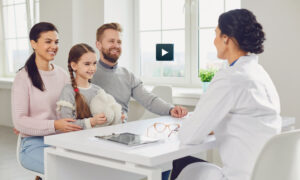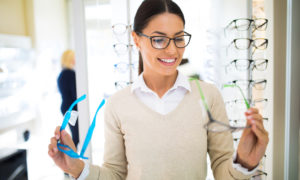By Ken Krivacic, OD, MBA

SYNOPSIS
Limiting excessively long exams leaves the patient more time to purchase eyewear in the optical dispensary. And doctor-staff-patient all welcome improved office flow.
ACTION POINTS
SET TIME LIMITS. Limit comprehensive exams to 20 minutes,contact lens follow-upsand short visits to 10minutes.
TRACK & MONITOR. Timecomprehensive examsand check time periodically in exam;bring patient back for further testing, if necessary.
BE PERSONABLE. Make brief conversation with patient; askabout their family or a recent vacation.
I closely track and limit appointments times in my office. That way patients don’t have to wait too long in the reception area for their appointment to begin, and then are left with ample time to shop in the optical after their exam. The less time spent in the exam room, the more time the patient has to spend in the optical.Patients allocate about one hour for a visit to the eye doctor. Beyond that, they have to return to work, pick up a child, run an errand. If you run long on the clinical side, you’re short-changing your optical retail side. This also gives our opticians more time to make sales. As with any purchase, no one likes to feel rushed. We have a two-doctor practice that grosses close to $2.5 million in annual revenues, and if we didn’t watch our time, I don’t think we would be anywhere close to that figure.
Staying on Time: Key Advantages
• Shows you respect the patient’s time
• Allows the patient more time in the optical area helping the practice’s bottom line.
• Shows your staff that you respect their time
• Helps reduce overtime pay
• You and your staff can go to lunch and go home on time
• Enhances your office reputation
• Reduces stress on both you and your staff
Set Time Limits on Each Appointment
In our schedule template we allow 20 minutes for what we consider a full or comprehensive eye exam and 10 minutes for other shorter exams such as contact lens follow-up visits, red eyes and additional testing such as visual fields, OCTs and photos.
Track Time in Exam Room
To keep track of time in the exam room, I believe you need a routine. Any process like an eye exam can follow a repeatable pattern on how it is performed. This can then be timed and an approximation can be calculated for how long it takes to perform the exam. Before we modified our schedule a few years ago we timed all our exams over a one-week period and used that figure to then set our current exam template. Armed with that information, I know most exams take me about 14 minutes to perform.
Does that mean I always stay on time? No way. Just as no two patients are alike, not all exams are alike. You can have very complicated cases that slow you down or you can get caught up in conversation with a patient. I do consciously watch the clock that is on our computer monitor to make sure I do not run over time.
If I am running behind, I need to decide if the patient can be rescheduled for further testing in a complicated case, or whether I need to quickly wrap up the conversation.
Make sure you build some over-run time into your schedule as invariably things can get out of hand and some slack time will help mitigate the stress caused by running behind.

Monitoring a master schedule, and noting time spent on various functions, helps to achieve time-limit goals in the practice. Above is Dr. Krivacic’s schedule for Nov. 6, 2014
Remain Personable With Patients
I used to believe patients just wanted an eye exam and the extra conversation was just wasting everyone’s time. That belief was based more on my personality than the actual expectations of the patient. I ama very results-oriented person, and there are a certain percentage of patients that also fall into that category. Yet most patients do like a small degree of small talk, and it is often those conversations–not just your clinical skills–that bind patients to you and your office. Now I make a point to at least mention something outside the usual clinical talk. That could be as simple as the weather or their last vacation. Again, I make sure to be aware of time so as to not let that conversation interfere with the exam information.
Give Patients Subtle Hint Exam Is Nearly Over
I don’t tell patients outright that I need to move on, but I normally try to end our encounter by asking a question like: “Do you have any other questions about the exam today?” This is a subtle way to say I need to get moving. Most patients take the hint and we move to close the exam.
Stay Aware of Exam Time Busters
The biggest time buster we face daily is the late patient. We do our best to make sure patients arrive on time (confirm all appointments, provide online patient registration, verify insurance coverage prior to the exam, etc.) yet invariably patients still arrive late. We do our best to work them into the schedule and let them know that those patients with scheduled exams will take priority. Occasionally we reschedule if the patient is going to interfere with our lunch schedule or end-of-the-day schedule.
Other time busters are the elderly patient who moves slower than the average patient or the difficult case. We do our best to speed them through the process by reducing the number of steps the patient makes through the office. In other words, in the clinical area of the office, the patient just makes one stop in the pre-test area and then completes the visit in the exam room without moving again until the exam is complete. In some difficult cases the patient may need to be scheduled later for further testing.
Keep Follow-Up Visits Short
To help speed up the process, the tech will do most of the work in a contact lens progress visit. They will take a brief history, acuities, auto-refraction and seat the patient in the exam room. If everything is going well then I need to only do a brief slit lamp and a handheld plusminus flipper test. To take it a step further, if the patient has been coming to us for some time and the change we made was small, we will do the follow-up visit with a phone call or e-mail. This reduces traffic in the office and speeds the patient through the follow-up process.
If the patient comes in for a contact lens follow-up and things are not going well then the best way to reduce time spent is to try not to move the patient around during the visit. Rather than take the patient to the contact lens area to change lenses we have the techs bring the contacts into the exam room to change lenses. This simple step change is a time saver.
Instrumentation Can Save Time
There are several instruments and changes we have implemented that have sped up the exam process. One of these was changing to a paperless office with EHR. Once you get used to the system, a few minutes per exam can be saved though the use of electronic medical records. You can even knock more time off by utilizing a scribe in the exam room.
A few years ago we equipped all our exam rooms with digital phoropters. This move has also sped up the exam process, particularly in the area of showing patients a change in their prescription. With a digital phoropter this can be accomplished with the push of a button rather than removing glasses and repositioning a standard phoropter in front of the patient.
Finally, the best way to speed up the exam process is to fully utilize your techs. Techs can perform the majority of the data gathering process freeing up the doctor to do only the tests a doctor can do and then discuss the case with the patient and make recommendations.
Get All Doctors in Practice On Time
To ensure that all doctors are on the same page about time management in the exam room there has to be communication. When a new doctor comes on board, one of the topics we discuss is the importance of staying on time. This is emphasized and trained for in the early stage of the doctor’s time with us. It is also communicated with all staff as this is a team effort, and we constantly retrain as needed. We mention to both doctors and staff that the ability to stay on time is a huge advantage to the patient and the practice, and should help our practice thrive and grow.
Related ROB Articles
Add Two Patients a Day: It Pays Off Big Time
Analyze Five Key Patient Experience Stages in Your Office
Smooth Operator: Keep Patients Moving Happily Through Your Office
Ken Krivacic, OD, is the owner of Las Colinas Vision Center in Irving, Texas. To contact him: kkrivacic@aol.com.



























